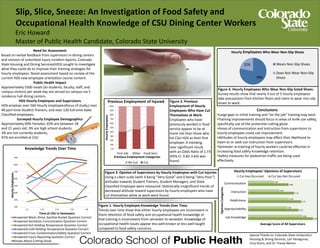
EricHowardMPHPoster
- 1. Slip, Slice, Sneeze: An Investigation of Food Safety and Occupational Health Knowledge of CSU Dining Center Workers Eric Howard Master of Public Health Candidate, Colorado State University Need for Assessment Based on verbal feedback from supervisors in dining centers and revision of submitted injury incident reports, Colorado State Housing and Dining Services(HDS) sought to investigate what they could do to improve their training strategies for hourly employees. Novel assessment based on review of the current HDS new employee orientation course content. Public Health Impact Approximately 5500 meals (to students, faculty, staff, and campus visitors) per week day are served on campus via 5 residence hall dining centers. HDS Hourly Employees and Supervisors HDS employs over 560 Hourly employees(focus of study,) over 40 part-time Student Trainers, and over 120 full-time State Classified employees. Surveyed Hourly Employee Demographics Approximately 60% Females, 65% are between 18 and 21 years old, 3% are high school students, 3% are not currently students, 91% are enrolled at CSU 20% 30% 40% 50% 60% 70% 80% 90% <1 1-2 2-3 3-4 >4 HourlyEmployees Time at CSU in Semesters Knowledge Trends Over Time Answered Wash, Rinse, Sanitize Bucket Question Correct Answered Sanitation Concentration Question Correct Answered Hot Holding Temperature Question Correct Answered Cold Holding Temperature Question Correct Answered Cross Contamination/Safety Question Correct Answered Injury Reporting Question Correct Knows About Cutting Glove Figure 1. Hourly Employee Knowledge Trends Over Time. Trends over time show that either hourly employees are inconsistent in there retention of food safety and occupational health knowledge or that training is inconsistent from semester to semester. Knowledge of occupational health issues appear less well known or less well taught compared to food safety concerns. 0% 10% 20% 30% 40% 50% 60% 70% 80% 90% 100% First Job Other Food Serv HourlyEmployees Previous Employment Categories Previous Employment of Injured No Cut Cut Figure 2. Previous Employment of Hourly Employees Who Have Cut Themselves at Work. Employees who have previously worked in food service appear to be at more risk than those who list CSU-HDS as their first employer. A trending, near significant result, with an Odds Ratio of 1.73 (95% CI 0.82-3.64) was found. 3.43 3.23 3.27 3.16 3.08 3.28 3.06 3.09 2.95 2.87 Job Knowledge Approachability Helpfulness Instruction Communication Average Score of All Supervisors OpinionCategories Hourly Employees’ Opinions of Supervisors Cut Has Occurred Cut Has Not Occured Figure 3. Opinion of Supervisors by Hourly Employees with Cut Injuries. Using a Likert scale (with 4 being “Very Good” and 0 being “Very Poor”) attitudes towards Student Trainers, Student Managers, and State Classified Employee were measured. Statistically insignificant trends of decreased attitude toward supervisors by hourly employees who have cut themselves while at work were found. 78% 22% Hourly Employees Who Wear Non-Slip Shoes Wears Non-Slip Shoes Does Not Wear Non-Slip Shoes Figure 4. Hourly Employees Who Wear Non-Slip Soled Shoes. Survey results show that nearly 4 out of 5 hourly employees take precautions from kitchen floors and claim to wear non-slip shoes to work. Special Thanks to: Colorado State University’s Housing & Dining Services, Lori Vanagunas, Cory Goins, and Dr. Tracey Nelson. Conclusions •Large gaps in initial training and “on the job” training may exist. •Training improvements should focus in areas of knife use safety, specifically use of the protective cutting glove. •Areas of communication and instruction from supervisors to hourly employees could use improvement. •Attitudes of hourly employees may effect their likelihood to listen to or seek out instruction from supervisors. •Semester re-training of hourly workers could be effective in increasing food safety knowledge retention. •Safety measures for pedestrian traffic are being used effectively.